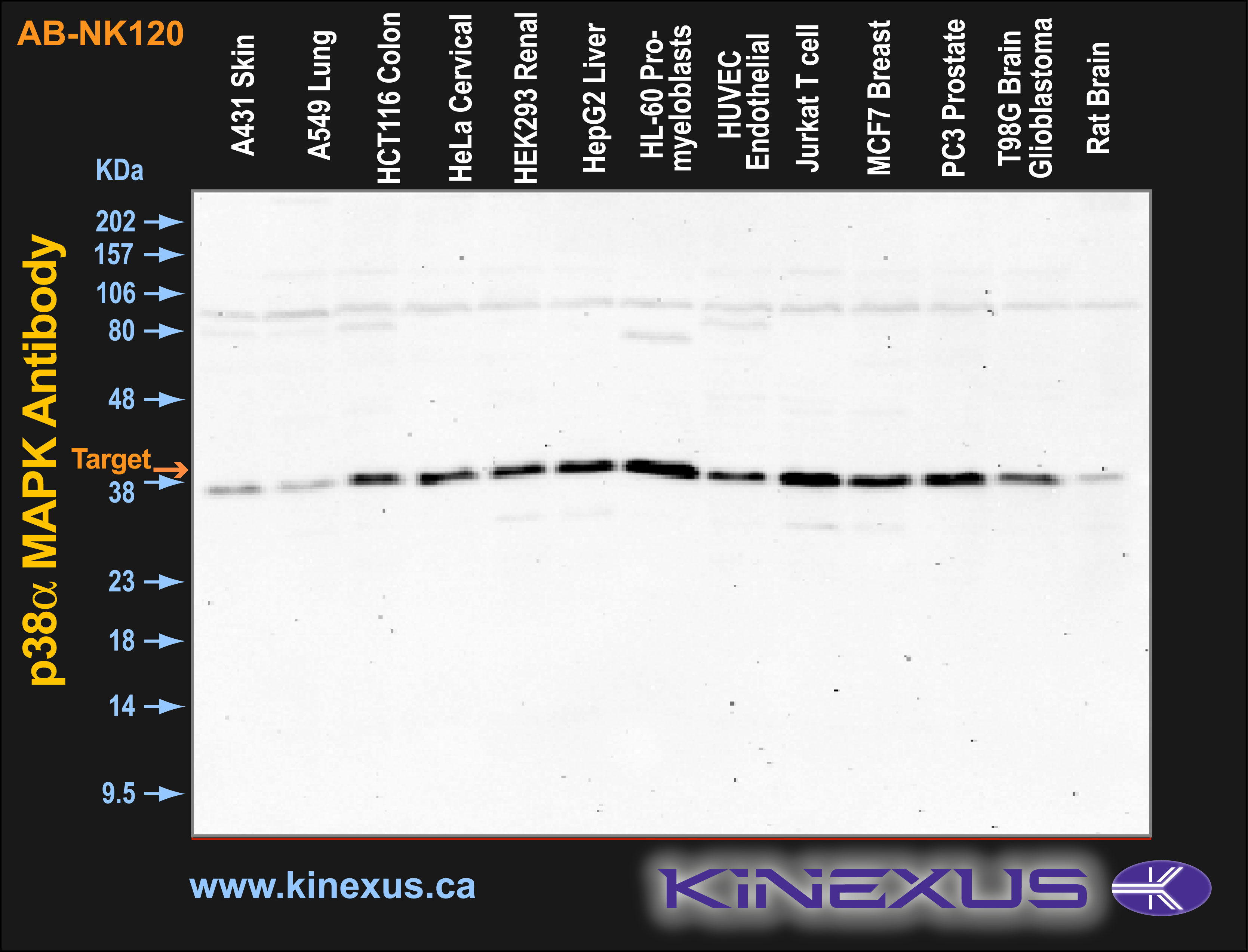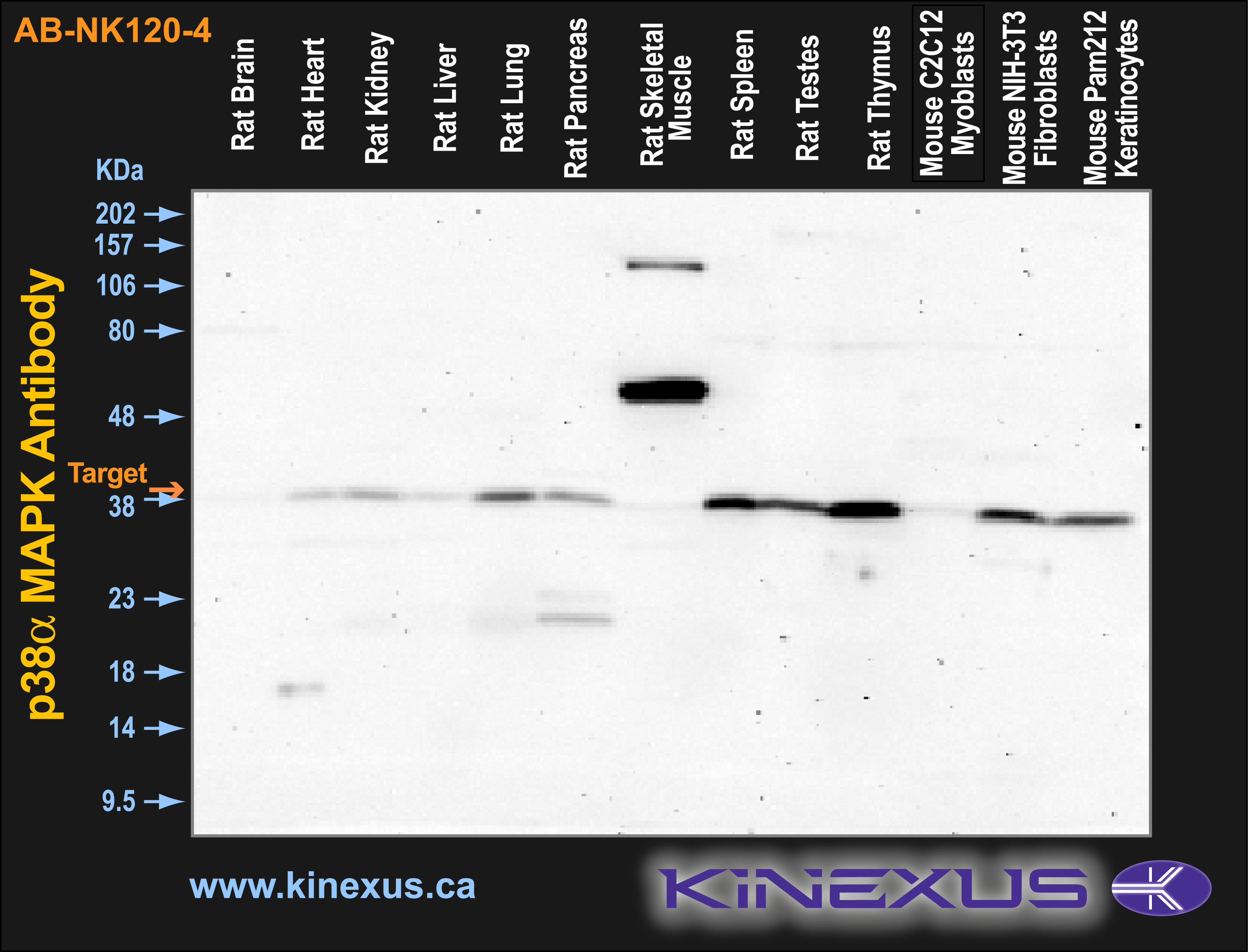Product Name: p38 alpha (MAP Kinase)
Product Number: AB-NK120-4
| Size: | 25 µg | Price: | 89.00 | |
| $US |
Target Full Name: Mitogen-activated protein kinase 14
Target Alias: CSAID Binding protein 1; CSBP1; CSBP2; EXIP; MAP kinase MXI2; MAPkinase p38alpha; MAPK14; p38 ALPHA; p38 MAP kinase; p38 mitogen activated protein kinase; RK; SAPK 2A; Stress activated protein kinase 2A
Product Type Specific: Protein kinase pan-specific antibody
Antibody Code: NK120-4
Antibody Target Type: Pan-specific
Protein UniProt: Q16539
Protein SigNET: Q16539
Antibody Type: Monoclonal
Antibody Host Species: Mouse
Antibody Ig Isotype Clone: IgG1
Target Alias: CSAID Binding protein 1; CSBP1; CSBP2; EXIP; MAP kinase MXI2; MAPkinase p38alpha; MAPK14; p38 ALPHA; p38 MAP kinase; p38 mitogen activated protein kinase; RK; SAPK 2A; Stress activated protein kinase 2A
Product Type Specific: Protein kinase pan-specific antibody
Antibody Code: NK120-4
Antibody Target Type: Pan-specific
Protein UniProt: Q16539
Protein SigNET: Q16539
Antibody Type: Monoclonal
Antibody Host Species: Mouse
Antibody Ig Isotype Clone: IgG1
Antibody Immunogen Source: Full length recombinant protein expressed in E.coli cells
Production Method: Protein G purified
Antibody Modification: Unconjugated. Contact KInexus if you are interest in having the antibody biotinylated or coupled with fluorescent dyes.
Antibody Concentration: 1 mg/ml
Storage Buffer: Phosphate buffered saline, 50% glycerol, 0.09% sodium azide
Storage Conditions: For long term storage, keep frozen at -40°C or lower. Stock solution can be kept at +4°C for more than 3 months. Avoid repeated freeze-thaw cycles.
Product Use: Western blotting | Immunohistochemistry | Immunoprecipitation | ELISA
Production Method: Protein G purified
Antibody Modification: Unconjugated. Contact KInexus if you are interest in having the antibody biotinylated or coupled with fluorescent dyes.
Antibody Concentration: 1 mg/ml
Storage Buffer: Phosphate buffered saline, 50% glycerol, 0.09% sodium azide
Storage Conditions: For long term storage, keep frozen at -40°C or lower. Stock solution can be kept at +4°C for more than 3 months. Avoid repeated freeze-thaw cycles.
Product Use: Western blotting | Immunohistochemistry | Immunoprecipitation | ELISA
Antibody Dilution Recommended: WB (1:1000); optimal dilutions for assays should be determined by the user.
Antibody Potency: Medium potency. Detects a ~38 kDa protein in cell and tissue lysates by Western blotting.
Antibody Species Reactivity: Human | Mouse | Rat
Antibody Positive Control: Detects ~38kDa protein corresponding to p38α MAPK when loaded with 6ng of purified p38α by chemiluminescent immunoblot analysis using Goat anti-mouse IgG:HRP as the secondary antibody.
Antibody Specificity: High
Related Product 1: p38 pan-specific antibody (Cat. No.: AB-NK120-5)
Related Product 2: p38a-2 pan-specific antibody (Cat. No.: AB-NK120-8)
Antibody Potency: Medium potency. Detects a ~38 kDa protein in cell and tissue lysates by Western blotting.
Antibody Species Reactivity: Human | Mouse | Rat
Antibody Positive Control: Detects ~38kDa protein corresponding to p38α MAPK when loaded with 6ng of purified p38α by chemiluminescent immunoblot analysis using Goat anti-mouse IgG:HRP as the secondary antibody.
Antibody Specificity: High
Related Product 1: p38 pan-specific antibody (Cat. No.: AB-NK120-5)
Related Product 2: p38a-2 pan-specific antibody (Cat. No.: AB-NK120-8)
Related Product 3: p38a-pT180+pY182 phosphosite-specific antibody (Cat. No.: AB-PK739)
Related Product 4: p38a-pT180+Y182 phosphosite-specific antibody (Cat. No.: AB-PK740)
Related Product 5: p38SelectideA - p38a MAPK (MAPK14) protein kinase substrate peptide
Related Product 6: p38Subtide - p38a MAPK (MAPK14) protein kinase substrate peptide
Related Product 4: p38a-pT180+Y182 phosphosite-specific antibody (Cat. No.: AB-PK740)
Related Product 5: p38SelectideA - p38a MAPK (MAPK14) protein kinase substrate peptide
Related Product 6: p38Subtide - p38a MAPK (MAPK14) protein kinase substrate peptide
Scientific Background: The MAPK (mitogen activated protein kinase) comprises a family of ubiquitous praline-directed, proteinserine/ threonine kinases which signal transduction pathways that control intracellular events including acute responses to hormones and major developmental changes in organisms (1). This super family consists of stress activated protein kinases (SAPKs); extracellular signal-regulated kinases (ERKs); and p38 kinases, each of which forms a separate pathway (2). The kinase members that populate each pathway are sequentially activated by phosphorylation. Upon activation, p38 MAPK/SAPK2α translocates into the nucleus where it phosphorylates one or more nuclear substrates, effecting transcriptional changes and other cellular processes involved in cell growth, division, differentiation, inflammation, and death (3). Specifically p38 always acts as a pro-apoptotic factor with its activation leading to the release of cytochrome c from mitochondria and cleavage of caspase 3 and its downstream effector, PARP (4). p38 MAPK is activated by a variety of chemical stress inducers including hydrogen peroxide, heavy metals, anisomycin, sodium salicylate, LPS, and biological stress signals such as tumor necrosis factor, interleukin-1, ionizing and UV irradiation, hyperosmotic stress and chemotherapeutic drugs (5). As a result, p38 alpha has been widely validated as a target for inflammatory disease including rheumatoid arthritis, COPD and psoriasis (6) and has also been implicated in cancer, CNS and diabetes (7).
Figure 1. Immunoblotting of various cell lines with AB-NK120-4 antibody at 2.5 µg/mL final concentration. The target protein p38a MAPK is indicated. Each lane was loaded with 15 µg of cell lysate protein. The max signal count was 11647.
Figure 2. Immunoblotting of various tissue lines with AB-NK120-4 antibody at 2.5 µg/mL final concentration. The target protein p38a MAPK is indicated. Each lane was loaded with 15 µg of tissue lysate protein. The max signal count was 18923.
References
[1] Pearson, G. et al (2001). Endocrine Reviews 22 (2): 153-183.
[2] Fan, Y. et al (2007) Mol. Cells 23 (1): 30-38.
[3] Han, J. et al. (1994) Science 265: 808-811.
[4] Van, L. A. et al. (2004) Faseb J. 18: 1946−1948.
[5] Deng et al. (2003) Cell. 115: 61-70.
[6] Salojin KV et al. (2006) J Immunol. 176 (3):1899-907.
[7] Medicherla S. et al. (2006). J Pharmacol Exp Ther.318(1): 99-107.
[1] Pearson, G. et al (2001). Endocrine Reviews 22 (2): 153-183.
[2] Fan, Y. et al (2007) Mol. Cells 23 (1): 30-38.
[3] Han, J. et al. (1994) Science 265: 808-811.
[4] Van, L. A. et al. (2004) Faseb J. 18: 1946−1948.
[5] Deng et al. (2003) Cell. 115: 61-70.
[6] Salojin KV et al. (2006) J Immunol. 176 (3):1899-907.
[7] Medicherla S. et al. (2006). J Pharmacol Exp Ther.318(1): 99-107.
© Kinexus Bioinformatics Corporation 2017



